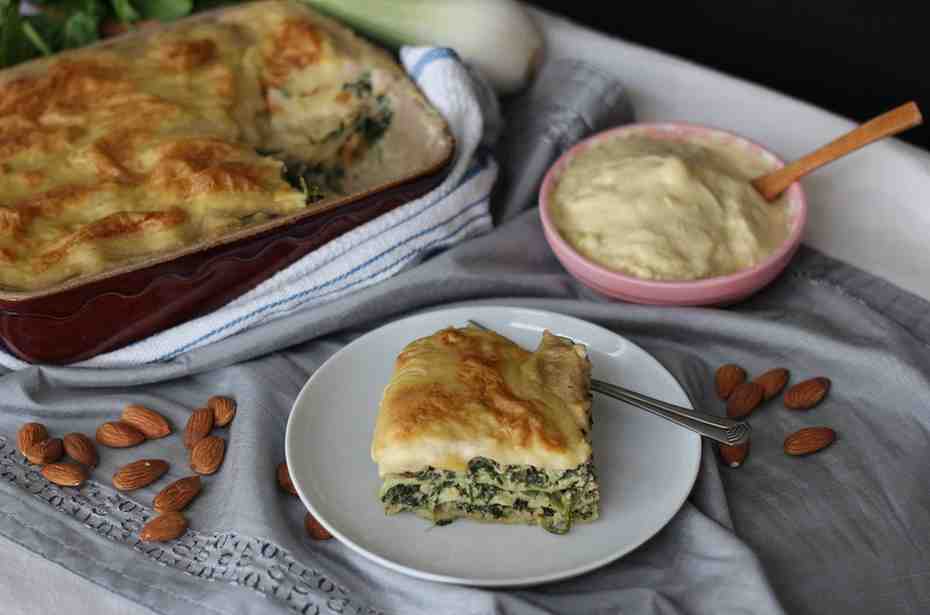Béchamel sauce, one of the five “mother sauces” of French cuisine, is a foundational element in many classic recipes. This smooth and velvety white sauce is used as a base for countless dishes, including gratins, lasagna, soufflés, and croquettes. Its subtle flavor allows it to complement various ingredients, adding creaminess without overwhelming the dish. Despite its seemingly simple nature, mastering béchamel sauce requires a careful balance of ingredients and technique.
What Is Béchamel Sauce?
At its core, béchamel sauce is made from three basic ingredients: butter, flour, and milk. The key to its rich, creamy texture lies in the roux—a combination of butter and flour cooked together—which acts as a thickening agent when mixed with milk. The resulting sauce is smooth and white, with a delicate flavor that can be seasoned or enhanced based on the dish it’s accompanying.
Béchamel sauce is often referred to as a “mother sauce” because it serves as a foundation for many other sauces, such as Mornay (béchamel with cheese), mustard sauce, and cream sauce. It also plays a crucial role in many baked dishes, where it provides moisture and binds ingredients together.
The Basic Formula for Béchamel Sauce
The traditional formula for béchamel sauce is relatively simple and follows a consistent ratio of ingredients. The standard proportions are:
- 2 tablespoons butter
- 2 tablespoons flour
- 1 cup milk
This ratio creates a medium-thick sauce, ideal for most purposes. If you need a thicker or thinner sauce, you can adjust the proportions of butter, flour, and milk accordingly.
Step-by-Step Guide to Making Béchamel Sauce

Making béchamel sauce is a straightforward process, but attention to detail is essential to avoid lumps and ensure a smooth consistency. Here’s a step-by-step breakdown:
Step 1: Make the Roux
The first step in making béchamel sauce is preparing the roux. The roux is made by melting butter in a saucepan over medium heat, then stirring in the flour. Here’s how it’s done:
- Melt the Butter: In a medium saucepan, melt 2 tablespoons of butter over medium heat. Be careful not to let the butter brown; you want it to stay pale and yellow.
- Add the Flour: Once the butter is fully melted, sprinkle in 2 tablespoons of flour. Stir constantly with a whisk or wooden spoon to combine the butter and flour. Continue to cook the roux for about 1-2 minutes, stirring constantly. The goal here is to cook off the raw flour taste, but you don’t want to let the roux brown, as this would change the color and flavor of the béchamel sauce.
- Check the Consistency: The roux should form a paste-like consistency. Once it’s smooth and bubbling, it’s ready for the next step.
Step 2: Add the Milk
The second step in the formula is adding milk to the roux. This transforms the roux into a creamy sauce:
- Warm the Milk: For the best results, warm the milk before adding it to the roux. Cold milk can cause the roux to seize up and form lumps, so gently heat 1 cup of milk in a separate saucepan or microwave until it’s just warm but not boiling.
- Gradually Add the Milk: Slowly pour the warm milk into the roux while whisking continuously. This step is crucial for preventing lumps from forming in the sauce. Adding the milk gradually allows the roux to absorb it evenly, creating a smooth sauce.
- Whisk Until Smooth: Continue whisking as the milk is added. The sauce will gradually thicken as the flour absorbs the liquid. Make sure to whisk out any lumps that might form.
- Simmer and Thicken: Once all the milk has been added, reduce the heat to low and let the sauce simmer for a few minutes. Continue whisking occasionally as the sauce thickens. The béchamel sauce is ready when it coats the back of a spoon and has a smooth, creamy texture.
Step 3: Season the Sauce
The final step in the formula is seasoning the béchamel sauce. While the basic version of the sauce is intentionally mild, a few simple seasonings can elevate its flavor:
- Salt and Pepper: Start by seasoning the sauce with salt and freshly ground white or black pepper. White pepper is often preferred in béchamel sauce because it blends seamlessly into the sauce without adding visible black specks.
- Nutmeg: One of the traditional seasonings for béchamel is a pinch of freshly grated nutmeg. Nutmeg adds warmth and a hint of complexity to the sauce without overpowering its subtle flavor.
- Optional Additions: Depending on the dish, you can add other seasonings or flavorings to the béchamel sauce. For example, you might stir in mustard, cheese, or herbs to customize the sauce to your liking.

Variations on Béchamel Sauce
Once you’ve mastered the basic béchamel formula, you can start experimenting with variations. Here are a few common adaptations of béchamel sauce:
Mornay Sauce
Mornay sauce is essentially a cheese-infused béchamel. To make it, follow the basic formula for béchamel, then stir in 1/2 cup of grated cheese (such as Gruyère, Parmesan, or cheddar) after the sauce has thickened. Mornay sauce is often used in gratins, macaroni and cheese, and other baked dishes that benefit from a creamy, cheesy sauce.
Mustard Sauce
For a tangy twist, you can turn béchamel into a mustard sauce by whisking in 1-2 tablespoons of Dijon mustard or whole-grain mustard. This variation pairs well with roasted meats, vegetables, and seafood.
Cream Sauce
If you want an even richer sauce, you can transform béchamel into cream sauce by replacing part of the milk with heavy cream. This variation is perfect for decadent dishes like chicken pot pie, creamy pasta dishes, or sauces for seafood.
Common Mistakes to Avoid
Béchamel sauce is relatively simple to make, but a few common mistakes can ruin the sauce’s smooth texture. Here are some tips to avoid these pitfalls:
- Lumps in the Sauce: The most common issue people encounter when making béchamel is lumps. To prevent lumps, make sure to whisk constantly as you add the milk, and always add the milk gradually rather than all at once. Warming the milk before adding it to the roux can also help prevent lumps.
- Burning the Roux: Be careful not to let the roux brown or burn while cooking. A burnt roux will give the béchamel sauce a bitter flavor and a darker color. Keep the heat at medium and stir constantly while cooking the roux.
- Too Thick or Too Thin Sauce: If your béchamel sauce is too thick, you can thin it out by whisking in a little more milk. If it’s too thin, let it simmer for a few more minutes to thicken, or add a small amount of roux (butter and flour mixture) if needed.
Serving Suggestions for Béchamel Sauce
Béchamel sauce is incredibly versatile and can be used in a wide variety of dishes. Here are some classic ways to serve and use it:
Lasagna
Béchamel sauce is a key ingredient in many traditional lasagna recipes, particularly in Italian versions such as Lasagna al Forno. Instead of ricotta or cottage cheese, béchamel provides a smooth and creamy layer between the sheets of pasta.
Croquettes
Croquettes are small, breaded, and fried rolls filled with various ingredients such as meat, seafood, or vegetables. Béchamel sauce is used as a binder for the filling, giving the croquettes their creamy interior.
Gratin
Gratin dishes, such as potato gratin or vegetable gratin, often use béchamel sauce as the base. The sauce helps bind the ingredients together and provides a rich, creamy texture that contrasts with the crispy, golden topping.
Soufflés
Béchamel sauce is the starting point for many savory soufflés. The thick sauce forms the base of the soufflé mixture, and the air whipped into the egg whites gives it its characteristic fluffy texture.
Final Thoughts on Béchamel Sauce
Béchamel sauce may be simple, but mastering it opens up a world of possibilities in the kitchen. By following the basic formula of butter, flour, and milk, and paying attention to technique, you can create a sauce that is smooth, creamy, and perfect for countless recipes. Once you’ve mastered the basics, feel free to experiment with variations and additional seasonings to suit your taste.
Whether you’re making a classic lasagna, a comforting gratin, or a batch of golden croquettes, béchamel sauce is a valuable tool in your culinary repertoire. With practice and a little patience, you’ll be able to create this essential sauce with ease.

